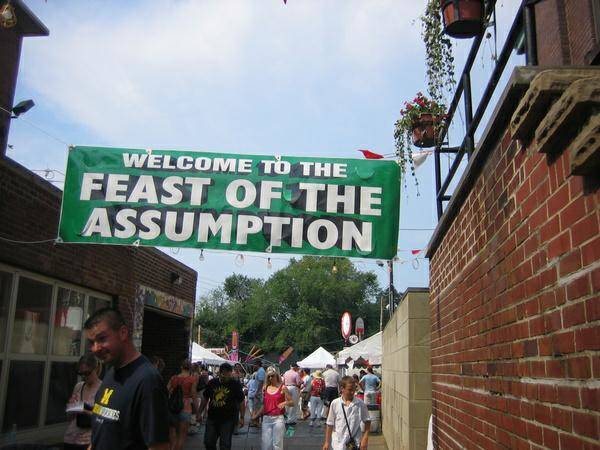Festivals: the Preservation of Culture
Late Summer. The season for Feasts, fairs and block parties in New York and beyond. A few years ago, I was in Cleveland, Ohio visiting a dear friend, Kristian Campana. Walking through the Italian neighborhood in Cleveland, Kristian introduced me to a Cassata cake. As you'll see in his article, it's a tad different than the traditional Sicilian Cassata.
Last year, Kristian started writing about all types of festivals in Ohio. Last weekend, he attended Cleveland's largest Italian Festival, the 112 year old, Feast of the Assumption. In the spirit of late summer Feasts and Festivals, here is his wonderful article.
Enjoy!
Thank you, Kristian!
Festivals: the Preservation of Culture
By Kristian Campana
I love festivals for their variations in themes, food and activity. Since I started blogging about Ohio festivals last year, I’ve been to more than 70.
They’re more than just funnel cakes and rides. They’re celebrations created to bring people together for particular reasons. A corn festival, for example, may be the perfect way to sell the harvest surplus. A frog jumping festival may be a fun excuse to educate children about nature.
This past weekend, I attended Cleveland’s biggest Italian festival – the Feast of the Assumption. Now in its 112th year, the festival brought in over 100,000 people who came to eat and celebrate all things Italian.
...the festival does more than just celebrate Italian culture. It preserves it.
From 1870 to 1920, a period before radio and television could help unify Italy through the language of Dante, more than 20,000 Italians came to Cleveland from cultures not tied so much to the country of Italy as they were to various Italian towns. My great grandparents from Barrea (Abruzzo), Bovalino (Calabria), and Cefalu’ (Sicily) didn’t understand each other when they arrived in the States, nor did they prepare the same dishes at home. They spoke different dialects, were accustomed to different foods and had different customs entirely.
They might as well have been from different countries.
But thanks to neighborhood churches, something magical happened in those Italian neighborhoods. In order to raise funds for the church, those Italians came together.
They prepared dishes known in their native towns and provided entertainment through local song and dance. When the non-Italian community first came to the festival to behold this new culture growing right there in Cleveland, they discovered many interesting things - tarantellas, pizza, pizzelle (ferratelle), zeppole, grappa, and morra. All these varied elements and more came together to create a definition of what Italian culture was.
Of course, the Cleveland community’s definition of Italian may differ slightly from other cities.
To give an example of this, I present you with the Cleveland cassata cake.
Consisting of yellow cake, a whipped cream topping and a filling of strawberries and custard, it’s not like the popular Sicilian cassata, nor the lesser-known Tuscan or Abruzzese versions. But it is part of Cleveland’s Italian culture, probably resulting from an Italian immigrant bringing it over and integrating it into the local culture. If there had been a greater influence of Sicilian immigrants, perhaps this version may have never taken hold. But it’s now the only cassata cake that the Clevelander knows because it was the only one integrated in that definition of Italian culture.
Of course, this isn’t to say that Cleveland holds an inaccurate definition of the Italian culture. The Italian culture was evolving long before Cleveland’s wave of Italian immigration and it’s still evolving today.
The Cleveland Feast of the Assumption is an example of a 100 year old cultural definition based on its blend of Italian immigrants. It’s a cultural time-capsule of how Italy once was at the time it was created - like an album filled with the snapshots carried over by each of those immigrants of that time period. And, although the details of those snapshots have faded away or been substituted by the descendents of those immigrants, festivals like the Feast of the Assumption have done what they could to preserve them.
I’m sure similar instances have occurred around the world in other cities of Italian immigration. And, if you attended Italian festivals in those cities, you may find other preserved stages in the evolution of Italy’s culture.
Perhaps you would find other treasures like the Cleveland cassata cake. Or perhaps various customs no longer practiced in Italy.
No matter where you go to celebrate the Italian tradition, it’s important to keep it alive. And what better way than by attending an Italian festival?
Because, even if you didn’t end up gaining any insight about your heritage or yourself, there’s always good food and people to make it worthwhile.





































i-Italy
Facebook
Google+
This work may not be reproduced, in whole or in part, without prior written permission.
Questo lavoro non può essere riprodotto, in tutto o in parte, senza permesso scritto.